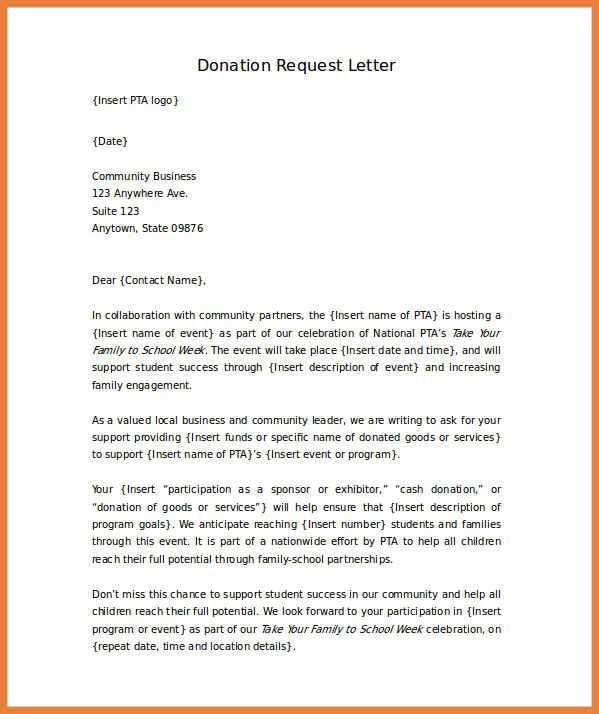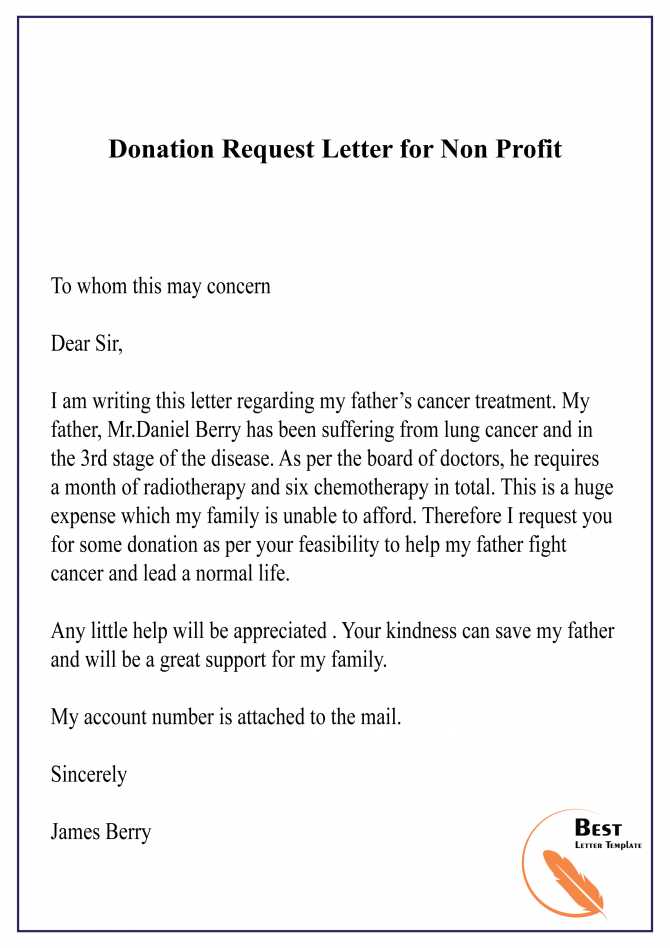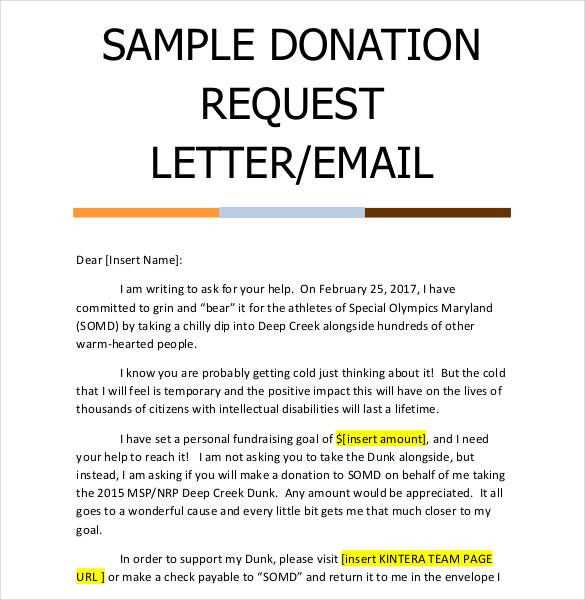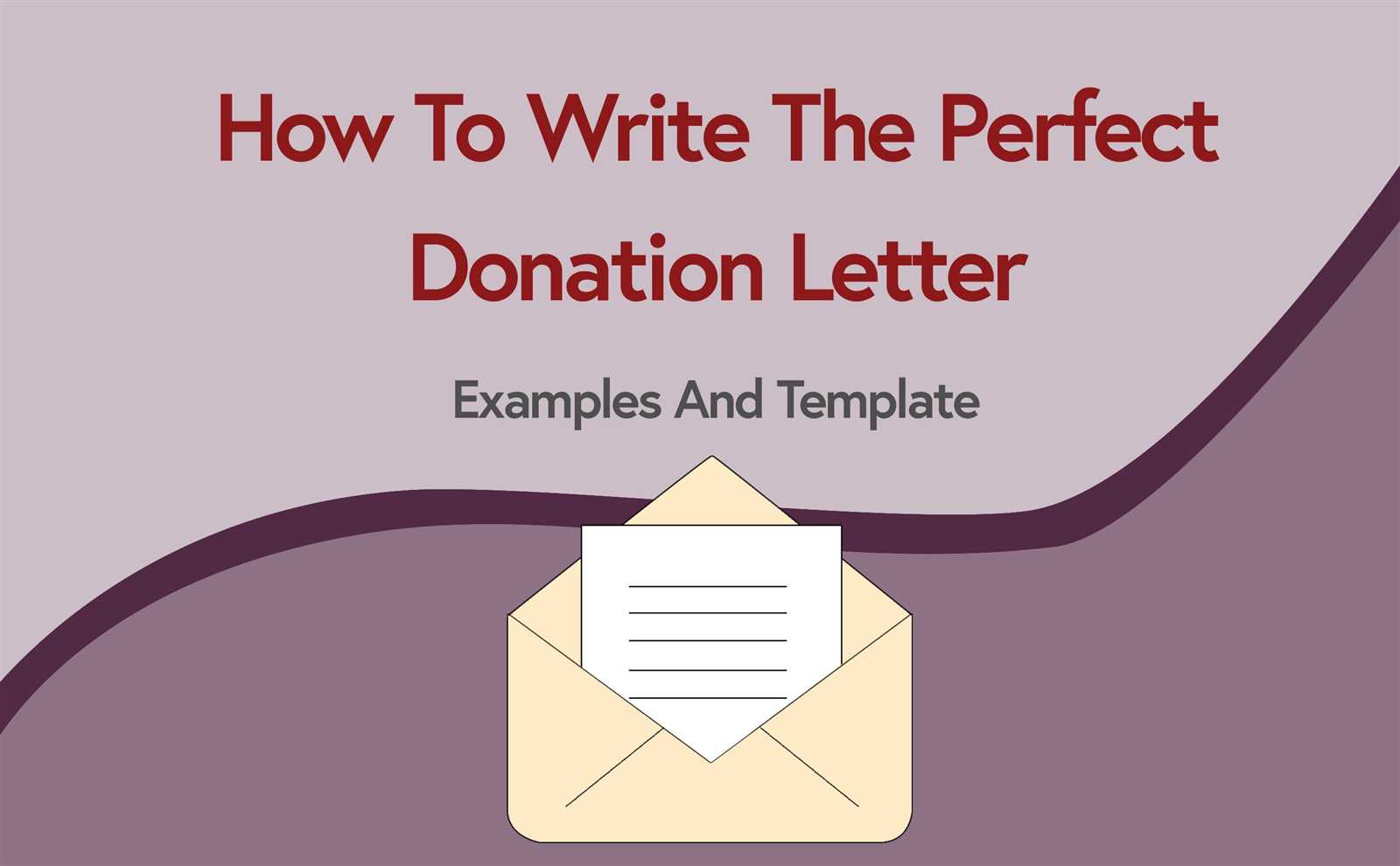Donation request letter template for nonprofit

To craft a compelling donation request letter, focus on clarity and directness. Your letter should immediately convey the purpose of your nonprofit and explain how donations will directly benefit your cause. Tailor the tone to match your audience, making sure it’s both personable and professional.
Start by introducing your nonprofit and its mission in a way that connects with the reader. Keep it concise yet impactful. Describe specific projects or programs that will be supported by the donation. This helps potential donors understand the tangible outcomes of their contributions.
Be transparent about the financial needs and how donations will be utilized. Providing a breakdown of how funds will be allocated shows trustworthiness and assures donors that their money will be used wisely. Always end the letter with a call to action, such as an easy way to donate or contact you for further details.
Here are the refined lines with repetition removed:
Focus on clarity and conciseness in your donation request letter. Redundant phrases and unnecessary elaborations can distract from your message. Simplify your language to maintain the reader’s attention.
Start with a direct appeal:
Instead of saying, “We are reaching out to ask for your generous support and contributions to our cause,” try, “We request your support for [cause].” It’s clear and to the point, eliminating filler words.
Highlight urgency without repetition:

Rather than repeating “now is the time to act” or similar phrases, focus on why immediate action matters. For instance, “Your contribution today will help us provide critical resources for those in need.” This communicates urgency without redundancy.
By cutting out repetitive phrases, you allow the core message to stand out, making it more compelling and easier for donors to understand how they can help.
- Donation Request Letter Template for Nonprofits
Use a clear, concise, and respectful approach when requesting donations. Personalize each letter for maximum impact. Below is a template that can be customized to suit your organization’s needs.
Subject: Request for Support for [Your Organization’s Name]
Dear [Recipient’s Name],
On behalf of [Your Organization’s Name], I’m reaching out to request your support for our mission to [briefly describe your mission]. We rely on generous donors like you to help us continue our work in [specific area or community].
Your contribution will help us [describe specific program, initiative, or project]. With your donation, we can [provide tangible outcomes, e.g., expand services, reach more individuals, purchase necessary supplies].
Donation Options
We offer a variety of ways to contribute. You can donate online at [website link], or send a check to [address]. If you have any questions, please feel free to contact us at [phone number] or [email address]. We would be happy to assist you.
We sincerely appreciate your consideration and hope to partner with you in making a lasting difference in our community. Thank you for your time and generosity!
Best regards,
[Your Name]
[Your Title]
[Your Organization’s Name]
[Contact Information]
Address your letter to the specific person who has the authority or interest in supporting your cause. Use a formal greeting, such as “Dear [Title] [Last Name].” If you’re unsure of the donor’s title, a neutral “Dear [Full Name]” works well. Make sure to double-check the spelling of their name and the correct use of titles, such as Dr., Mr., or Ms.
Personalize the letter by referencing any previous interactions or shared connections if applicable. For example, “It was a pleasure meeting you at [event].” This shows you value the relationship and are not sending a generic request.
If the donor is someone you don’t know personally, keep the tone respectful but not overly formal. You can begin with a more general greeting, like “Dear Friend of [Organization Name],” which can still feel sincere but remains professional.
Be mindful of the donor’s preferences and position. If they are a business, address the letter to the company or a specific department. If it’s an individual, make sure your tone aligns with their status or role, avoiding overly casual language.
Key Elements to Include in Your Donation Request Letter

Begin with a personalized greeting. Address the recipient by name whenever possible to create a connection. A warm introduction sets the tone for the rest of the letter.
- Clear Purpose: State the specific need for donations right away. Explain what the funds will support–whether it’s a project, program, or specific initiative. Being transparent builds trust.
- Impact of Donation: Illustrate how the donation will make a difference. Use tangible examples to show the potential impact, whether it’s reaching more people, improving services, or achieving a specific goal.
- Amount or Range: Include a suggested donation amount or range. Don’t leave the reader guessing. This can help guide their contribution and demonstrate what different donation levels can accomplish.
- Call to Action: Make it easy for the recipient to take the next step. Include clear instructions on how to donate, whether it’s online, by check, or other methods. Provide direct links if applicable.
- Closing Statement: Thank the reader in advance for considering your request. A genuine, appreciative closing reinforces the relationship you aim to build with potential donors.
Including these elements creates a structured, engaging, and persuasive donation request letter that motivates action.
Tailor your donation request based on the donor’s interests and history with your organization. For major donors, highlight how their contributions have led to specific impactful outcomes, such as funding a key project or expanding services. Express gratitude for their continued support and explain how additional funds will help build on those successes.
For corporate donors, emphasize the potential benefits of their partnership. Show how supporting your cause can align with their corporate social responsibility goals, boost their brand image, and foster employee engagement. Make sure to include any recognition opportunities for their company.
When reaching out to smaller individual donors, make the request personal. Mention their past donations, even if small, and how those contributions helped make a difference. Personal stories of the people or communities they’ve impacted can strengthen this connection.
For new donors, keep the tone welcoming and informative. Provide a clear, concise overview of your mission and how their support will directly impact your cause. Offer options for engagement beyond donations, such as volunteering or attending an event, which helps establish a longer-term relationship.
Personalizing a donation request helps donors feel directly involved in your cause and increases the likelihood of continued support.
Be direct, sincere, and focused on the cause. Use language that reflects the urgency of your mission and makes donors feel like they can make a tangible impact. Write as if you are talking to someone personally, not just addressing a broad audience.
1. Build a Connection
Start with clear, empathetic language. Convey how the donation will directly benefit those in need. Describe the specific outcome of their support–whether it’s funding a project or providing essential resources.
2. Be Positive and Hopeful
Even though your nonprofit might be addressing a serious issue, maintaining an optimistic tone can inspire potential donors to take action. Highlight the positive changes their contributions can bring, and use language that reflects the difference they will make.
3. Use Simple and Clear Language
Don’t complicate your message with jargon. Your donors may not be familiar with the specifics of your work, so ensure your appeal is easy to read and understand. Clear and concise sentences are more likely to drive action.
4. Avoid Overloading with Information
Keep the focus on the key message. While you may want to share facts and statistics, be selective. A concise appeal will hold attention better than one filled with too many details.
| Effective Tone | Avoided Tone |
|---|---|
| Empathetic, hopeful, direct | Desperate, overly formal, vague |
| Clear and simple | Overly technical, abstract |
| Personal and warm | Impersonal, detached |
Be clear and specific about your needs. Don’t leave potential donors wondering how their contribution will be used. State the exact amount or resources you need and the impact it will have on your mission.
Avoid Being Vague
General requests can come across as unorganized or unthoughtful. Instead of saying, “We need donations for our cause,” specify, “We need $5,000 to provide medical supplies for 100 children in need.” This transparency builds trust and provides a sense of purpose for the donor.
Don’t Overwhelm with Information

Too much detail can overwhelm the reader and detract from your key message. Focus on the essentials–who you are, what you do, and why the donation is necessary. Keep the letter concise and to the point, highlighting the most compelling reasons for their support.
- Be specific about the impact of their donation.
- Avoid unrelated information that doesn’t directly support your request.
Skip the Hard Sell
While it’s tempting to emphasize urgency or guilt-trip potential donors, this can have the opposite effect. Maintain a respectful tone. Highlight how their donation will make a tangible difference without pressuring them. An appeal based on shared values will resonate far more than a plea based on fear or guilt.
Neglecting Follow-Up
Never leave a donation request without offering a follow-up plan. Let your donors know when they can expect updates or how they can get involved beyond just giving money. This shows that you value their support and fosters a long-term relationship.
Using a One-Size-Fits-All Approach
Tailor each request to the recipient. A generic, mass-produced letter feels impersonal. Research your potential donor and align your request with their interests or past contributions. A personalized touch can significantly increase the chances of success.
Follow up with a polite reminder after sending your donation request. A good time for the first follow-up is about 7-10 days after the initial letter. Ensure your message is brief and appreciative, reaffirming your mission and the difference their contribution will make.
Timing Matters
Choose the right moment to follow up. You don’t want to seem too eager, but you also want to stay fresh in their minds. Send a gentle reminder a week after the first letter. If you don’t hear back after that, consider sending another follow-up a couple of weeks later, offering a more personal touch, perhaps including an update on your organization’s progress.
Personalize Your Message
Each follow-up should feel unique. Address the recipient by name, and reference the donation request letter they received. This shows that you’re engaging directly with them, not sending mass messages. You can also share any recent success stories or news that highlights the impact of donations.
Keep your tone friendly and respectful, and always express gratitude for their consideration, regardless of whether they have donated yet.
Now repetition of words is minimized, but the meaning remains unchanged.
Focus on clarity and brevity in your donation request letter. Keep sentences direct and purposeful to ensure the reader quickly grasps the main points without distractions. Avoid redundant phrases that may dilute the impact of your message.
Tips to Strengthen Your Letter
Start by clearly stating your cause and its goals. Include the most compelling details about how donations will make a direct impact. Support your request with specific examples of past successes or future plans. Make sure the donor understands how their contribution will create a meaningful difference.
| Action | Result |
|---|---|
| Clearly define your mission | Immediate understanding of purpose |
| Use concise language | Message is absorbed quickly |
| Provide clear examples | Increased trust and emotional connection |
Streamlining Your Request
Minimize extraneous details and keep your message focused on the essentials. Use an approachable tone to invite donors into the cause without overwhelming them with too much information. Your goal is to spark interest and motivate action with minimal friction.